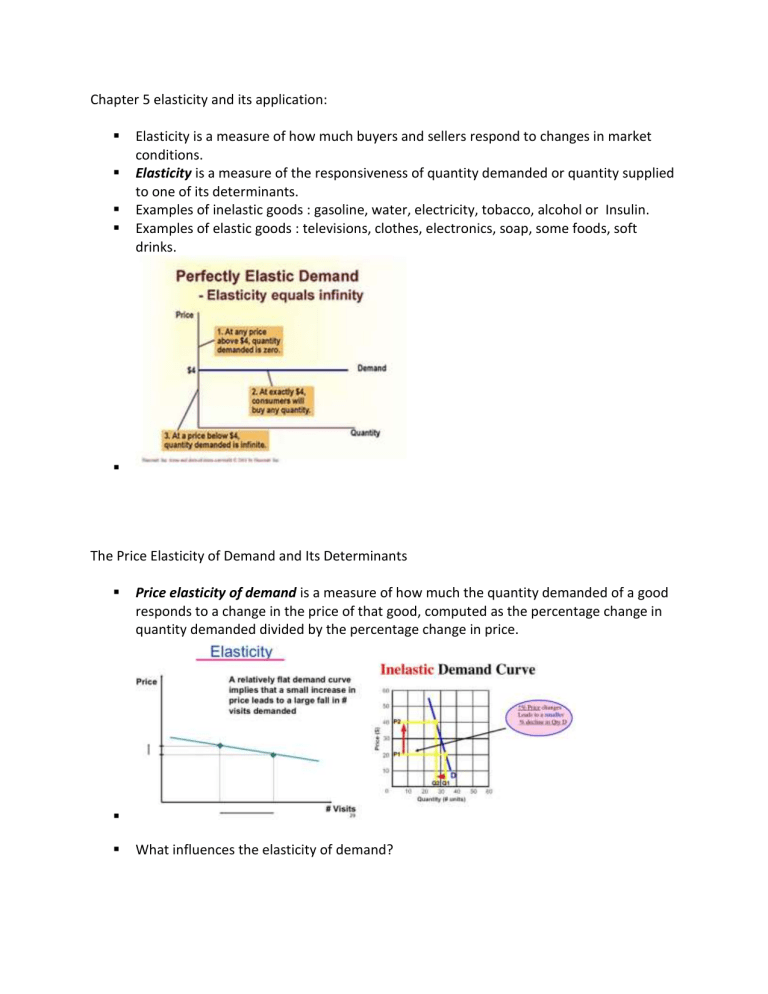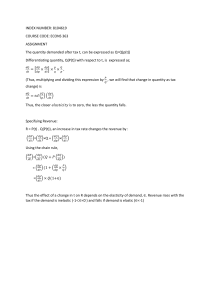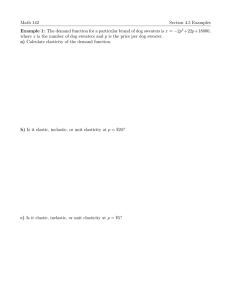
Chapter 5 elasticity and its application: Elasticity is a measure of how much buyers and sellers respond to changes in market conditions. Elasticity is a measure of the responsiveness of quantity demanded or quantity supplied to one of its determinants. Examples of inelastic goods : gasoline, water, electricity, tobacco, alcohol or Insulin. Examples of elastic goods : televisions, clothes, electronics, soap, some foods, soft drinks. The Price Elasticity of Demand and Its Determinants Price elasticity of demand is a measure of how much the quantity demanded of a good responds to a change in the price of that good, computed as the percentage change in quantity demanded divided by the percentage change in price. What influences the elasticity of demand? The four factors that affect price elasticity of demand are: (1) availability of substitutes, (2) if the good is a luxury or a necessity, (3) the proportion of income spent on the good, and (4) how much time has elapsed since the time the price changed. If the % change in quantity demanded is less than the % change in price, the demand for a product is relatively inelastic If the % change in the quantity demanded is greater than the % change in price, the demand for the product is relatively elastic. Peculiarity: Diamonds are an article on Snob Appeal. Articles of Snob Appeal are those commodities that are used to enhance the image of the person and an exception to the law of demand. The Variety of Demand Curves Demand is elastic when the elasticity is greater than 1, so that quantity moves proportionately more than the price. Demand is inelastic when the elasticity is less than 1, so that quantity moves proportionately less than the price. If the elasticity is exactly 1, so that quantity moves the same amount proportionately as price, demand is said to have unit elasticity. If the elasticity equals 0 this is an perfectly inelastic demand Perfectly elastic de3mand is when elasticity equals infinity Total Revenue and the Price Elasticity of Demand Total revenue (in a market) is the amount paid by buyers and received by sellers of a good, computed as the price of the good times the quantity sold. The examples in Figure 5.3 illustrate some general rules: 1. When demand is inelastic (a price elasticity less than 1), price and total revenue move in the same direction. 2. When demand is elastic (a price elasticity greater than 1), price and total revenue move in opposite directions. 3. If demand is unit elastic (a price elasticity exactly equal to 1), total revenue remains constant when the price changes. Other Demand Elasticities In addition to the price elasticity of demand, economists also use other elasticities to describe the behavior of buyers in a market: If income elasticity is positive, the good is normal. If income elasticity is negative, the good is inferior. The Price Elasticity of Supply and Its Determinants Price elasticity of supply is a measure of how much the quantity supplied of a good responds to a change in the price of that good, Supply of a good is said to be: Elastic if the quantity supplied responds substantially to changes in the price. Inelastic if the quantity supplied responds only slightly to changes in the price. Supply is usually more elastic in the long run than in the short run. The Variety of Supply Curves • In the extreme case of a zero elasticity, as shown in panel (a), supply is perfectly inelastic, and the supply curve is vertical. In this case, the quantity supplied is the same regardless of the price. • As the elasticity rises, the supply curve gets flatter, which shows that the quantity supplied responds more to changes in the price • • At the opposite extreme, shown in panel (e), supply is perfectly elastic. This occurs as the price elasticity of supply approaches infinity and the supply curve becomes horizontal, meaning that very small changes in the price lead to very large changes in the quantity supplied. Summary Elasticity is a general measure of the responsiveness of an economic variable in response to a change in another economic variable. The three major forms of elasticity are price elasticity of demand, cross-price elasticity of demand, and income elasticity of demand. The four factors that affect price elasticity of demand are (1) availability of substitutes, (2) if the good is a luxury or a necessity, (3) the proportion of income spent on the good, and (4) how much time has elapsed since the time the price changed. If income elasticity is positive, the good is normal. If income elasticity is negative, the good is inferior.





